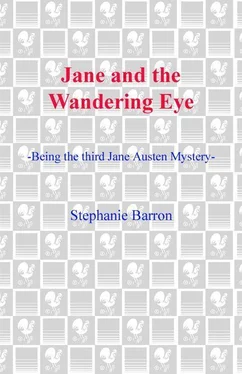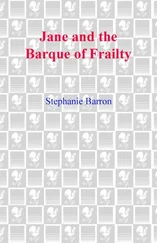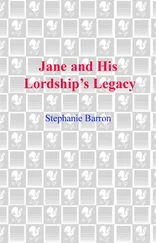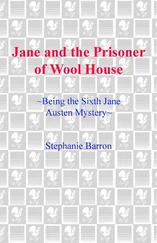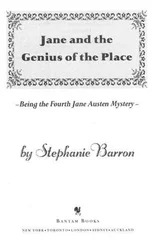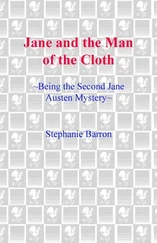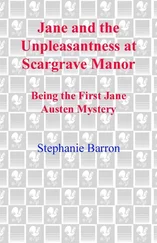Stephanie Barron - Jane and The Wandering Eye
Здесь есть возможность читать онлайн «Stephanie Barron - Jane and The Wandering Eye» весь текст электронной книги совершенно бесплатно (целиком полную версию без сокращений). В некоторых случаях можно слушать аудио, скачать через торрент в формате fb2 и присутствует краткое содержание. Жанр: Исторический детектив, Иронический детектив, на английском языке. Описание произведения, (предисловие) а так же отзывы посетителей доступны на портале библиотеки ЛибКат.
- Название:Jane and The Wandering Eye
- Автор:
- Жанр:
- Год:неизвестен
- ISBN:нет данных
- Рейтинг книги:3 / 5. Голосов: 1
-
Избранное:Добавить в избранное
- Отзывы:
-
Ваша оценка:
- 60
- 1
- 2
- 3
- 4
- 5
Jane and The Wandering Eye: краткое содержание, описание и аннотация
Предлагаем к чтению аннотацию, описание, краткое содержание или предисловие (зависит от того, что написал сам автор книги «Jane and The Wandering Eye»). Если вы не нашли необходимую информацию о книге — напишите в комментариях, мы постараемся отыскать её.
Jane and The Wandering Eye — читать онлайн бесплатно полную книгу (весь текст) целиком
Ниже представлен текст книги, разбитый по страницам. Система сохранения места последней прочитанной страницы, позволяет с удобством читать онлайн бесплатно книгу «Jane and The Wandering Eye», без необходимости каждый раз заново искать на чём Вы остановились. Поставьте закладку, и сможете в любой момент перейти на страницу, на которой закончили чтение.
Интервал:
Закладка:
Persons pursued for debt could be seized at any time or place, except in the Liberties of the Savoy, a few square blocks in the heart of London, where debtors were accorded sanctuary. Similarly, a member of Parliament could not be taken up for debt. — Editor’s note.
46
It was the custom in the theater of the time to stage two performances each evening. Lovers’ Vows was produced no less than six times in the years Jane spent in Bath; her dislike of and familiarity with the play, as well as its immense popularity, probably caused her to use it for the Bertram family’s amateur theatricals in Mansfield Park. In that novel, Mary Crawford is Amelia and Edmund Bertram is cajoled into portraying the morose clergyman Anhalt. — Editor’s note.
47
Public hangings in Tyburn (now Marble Arch) were a thing of memory by 1804, with most such executions taking place before the gates of Newgate prison; but Jane refers to the public crush and brawling for seats that hangings had formerly occasioned. — Editor’s note.
48
Dorothy Jordan, a comic actress of great renown, unwillingly shared the stage at Drury Lane with the Kemble family throughout the 1780s and ‘90s. Jordan was the mistress of the Duke of Clarence, George Ill’s third son, and bore him ten children before he abandoned her in her old age. — Editor’s note.
49
The fighting of duels between gentlemen like Colonel Easton and the Earl, although very common in Austen’s day as a means of settling disputes, was nonetheless illegal. If a duelist were mortally wounded, his assailant was liable for murder. A common circumvention of this result was escape to the Continent — although with England at war with France, such havens were dwindling. — Editor’s note.
50
In Austen’s day, theaters existed by permission of the monarch. Actors and actresses were still expected, as a result, to perform in court dress, as though in the presence of the king. Although this habit had begun to give way to period costuming in such places as Covent Garden and Drury Lane, it remained the convention. Men who sported the Brutus wore their hair brushed forward along the temples like a Roman of Caesar’s day. — Editor’s note.
51
John Wood (1704–1754) was Bath’s principal architect. He and his son of the same name (died 1782) envisioned and built the city’s principal landmarks, the crescents of houses constructed of similar materials and designed to appear as a single great estate. Laura Place, however, was constructed in 1788, well after Wood’s time, according to plans laid out by Thomas Baldwin. — Editor’s note.
52
Thomas Lawrence (1769–1830) would actually have been closer to thirty-five in 1804. Although Austen describes him as having a fine head, and a surviving self-portrait suggests he was quite handsome, he eventually went bald. — Editor’s note.
53
This description of Sir Egerton Brydges’s Arthur Fitz-Albini is very similar to one Jane gives of the novel in a letter to Cassandra written soon after its publication, in 1798. The Reverend George Austen had purchased the book, and Jane felt a little guilty in reading it, given Madam Lefroy’s poor opinion of the work. See Letter No. 1 2, Jane Austen’s Letters , Deirdre LeFaye, ed., London: Oxford University Press, 1995. — Editor’s note.
54
Thomas Lawrence’s 1801 portrait of Lady Caroline Upton, coiffed fashionably à la grecque , hangs in the Sterling and Francine Clark Art Institute, Williamstown, MA. — Editor’s note.
55
A man involved in a duel always appointed a “second” who negotiated the terms of the duel with his opponent’s second and, in extreme cases, might be expected to fight on his behalf. — Editor’s note.
56
Beau Nash was Master of Ceremonies for the Bath Assembly up to his death in 1761, and believed himself responsible for the regulation of public conduct. He forced those who frequented the Rooms — duchess and commoner alike — to a rigid standard of etiquette that survived him by fully fifty years. — Editor’s note.
57
This was a riding school located in Montpelier Street, where, for a seasonal subscription, the gentry might receive instruction in riding or hire mounts for their use. — Editor’s note.
58
A man or boy holding aloft a lamp — or “link” — ran before the sedan chair at night, to warn pedestrians and to illuminate the route. — Editor’s note.
59
From their familiarity with the streets and their presence at all hours, chairmen served as almost a police force in Bath, although an unregulated one; they were known to occasionally hold their fares captive, for the extortion of money. — Editor’s note.
60
Readers of Persuasion will be familiar with Molland’s, where Anne Elliot reencounters Captain Frederick Wentworth in a sudden Bath rainstorm. — Editor’s note.
61
The coat-of-arms of the Prince of Wales is a crown surmounted by three ostrich plumes. Both his acknowledged wife — Caroline, Princess of Wales — and Mrs. Fitzherbert, the Catholic to whom he had been previously married by an Anglican priest in 1786, sported the three feathers throughout their households. — Editor’s note.
62
Those respectful of the Sabbath rarely traveled on Sunday in Austen’s time. — Editor’s note.
63
The Crescent refers not to the imposing houses of the Royal Crescent on Brock Street, but to the broad green immediately opposite, where all of fashionable Bath was wont to walk on Sunday afternoons. — Editor’s note.
64
Cassandra Austen was engaged in 1792 to marry the Reverend Thomas Craven Fowle (1765–1797), son of the Austens’ lifelong friends and a protégé of Lord Craven, whose naval expedition to the West Indies in 1795 Fowle felt obligated to join. He died of yellow fever in San Domingo in February 1797. He left Cassandra a legacy of one thousand pounds. — Editor’s note.
65
An Indiaman was a merchant ship transporting cargo from the East Indies. They were usually owned by the Honourable East India Company, but in this case, we may read the term to indicate one of the Earl’s private vessels. — Editor’s note.
66
Since magistrates were appointed by influential patrons, Lord Harold is suggesting that Mr. Elliot’s career might be at risk. — Editor’s note.
67
James Austen’s first wife, Anne Mathew, whom he married in 1792, died suddenly in 1795 — after which he married Mary Lloyd, the sister of Jane’s lifelong friend Martha. Martha would later become Frank Austen’s second wife. — Editor’s note.
68
This description of Anne Lefroy’s death accords quite closely with that contained in the family memoir Jane Austen: A Family Record (by William Austen-Leigh and Richard Arthur Austen-Leigh, revised by Deirdre LeFaye, London: The British Library, 1989). — Editor’s note.
69
Jane ascribes similar feelings, in virtually the same language, to Anne Elliot of Persuasion —a woman who, at twenty-seven, regrets the advice of her older friend, Lady Russell, who discouraged her attachment eight years previously to a young sailor without prospects. Jane allowed Anne Elliot to be eventually reunited with Captain Frederick Wentworth. — Editor’s note.
Читать дальшеИнтервал:
Закладка:
Похожие книги на «Jane and The Wandering Eye»
Представляем Вашему вниманию похожие книги на «Jane and The Wandering Eye» списком для выбора. Мы отобрали схожую по названию и смыслу литературу в надежде предоставить читателям больше вариантов отыскать новые, интересные, ещё непрочитанные произведения.
Обсуждение, отзывы о книге «Jane and The Wandering Eye» и просто собственные мнения читателей. Оставьте ваши комментарии, напишите, что Вы думаете о произведении, его смысле или главных героях. Укажите что конкретно понравилось, а что нет, и почему Вы так считаете.
